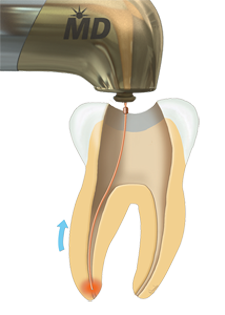Laser therapy melts away the debris consisting of bacteria and infection, biologically known as the "smear layer" of the root, and cleans the root more thoroughly and effectively than traditional treatments. With less time and pain than a conventional root canal, laser dentistry can remove your infection so that you can get on with your life.
New laser technology promises to change the way you experience traditional endodontic or root canal therapy.
The invention of the Dental Lasers has changed the way some dentists perform root canals.Sometimes a laser and a high-pressure water system to remove dead tissue and infection from the root's canal is highly effective.The root canal laser system produces enough heat and pressure to remove debris without using drills or hand files, cutting down the time spent in the dental chair and is very effective.
Microorganisms can hide in the dentinal tubules of the dentin surrounding the root. With conventional root canals, the cleaning process doesn't always reach all of the tubules, leaving behind some of the bacteria well after the root canal is filled and sealed.The laser penetrates deep into the porous tubules, removing bacteria without damaging the surrounding tissue. While traditional root canal instruments only clean out the tooth's root, the laser actually sterilizes it, increasing your chances of a successful procedure.
 Laser technology also reduces possible side effects from the root canal procedure. There's no need to worry about files breaking off or getting stuck in the canal. The laser also limits the amount of bleeding during dental treatment. Post-operative problems of traditional root canals are practically eliminated -- the laser reduces the amount of inflammation,swelling and discomfort often felt as the anesthesia wears off. Patients may not even need pain medication often prescribed following dental surgery.
Laser technology also reduces possible side effects from the root canal procedure. There's no need to worry about files breaking off or getting stuck in the canal. The laser also limits the amount of bleeding during dental treatment. Post-operative problems of traditional root canals are practically eliminated -- the laser reduces the amount of inflammation,swelling and discomfort often felt as the anesthesia wears off. Patients may not even need pain medication often prescribed following dental surgery.
Lasers are perfect for reaching areas that metal instruments don't. Some dentists are combining both the laser and traditional hand pieces for optimal effects. Remember, your dentist's goal is to save your tooth and get you out of pain, so regardless of what type of procedure you choose.
New laser technology promises to change the way you experience traditional endodontic or root canal therapy.
The invention of the Dental Lasers has changed the way some dentists perform root canals.Sometimes a laser and a high-pressure water system to remove dead tissue and infection from the root's canal is highly effective.The root canal laser system produces enough heat and pressure to remove debris without using drills or hand files, cutting down the time spent in the dental chair and is very effective.
Microorganisms can hide in the dentinal tubules of the dentin surrounding the root. With conventional root canals, the cleaning process doesn't always reach all of the tubules, leaving behind some of the bacteria well after the root canal is filled and sealed.The laser penetrates deep into the porous tubules, removing bacteria without damaging the surrounding tissue. While traditional root canal instruments only clean out the tooth's root, the laser actually sterilizes it, increasing your chances of a successful procedure.
 Laser technology also reduces possible side effects from the root canal procedure. There's no need to worry about files breaking off or getting stuck in the canal. The laser also limits the amount of bleeding during dental treatment. Post-operative problems of traditional root canals are practically eliminated -- the laser reduces the amount of inflammation,swelling and discomfort often felt as the anesthesia wears off. Patients may not even need pain medication often prescribed following dental surgery.
Laser technology also reduces possible side effects from the root canal procedure. There's no need to worry about files breaking off or getting stuck in the canal. The laser also limits the amount of bleeding during dental treatment. Post-operative problems of traditional root canals are practically eliminated -- the laser reduces the amount of inflammation,swelling and discomfort often felt as the anesthesia wears off. Patients may not even need pain medication often prescribed following dental surgery.
Why do treatments fail even when all canals are located and cleaning and enlargement is successful? Research shows that most root canal treatment failures are caused by persistent or secondary intraradicular infections, with E. faecalis, the most prevalent species. Lasers may help reduce root canal failures.



Thank you for posting this wonderful blog about the benefits of laser root canal treatment. I'd like to congratulate you on your work. Have a great rest of your day and keep up the posts.
ReplyDeleteDentist Center City Philadelphia